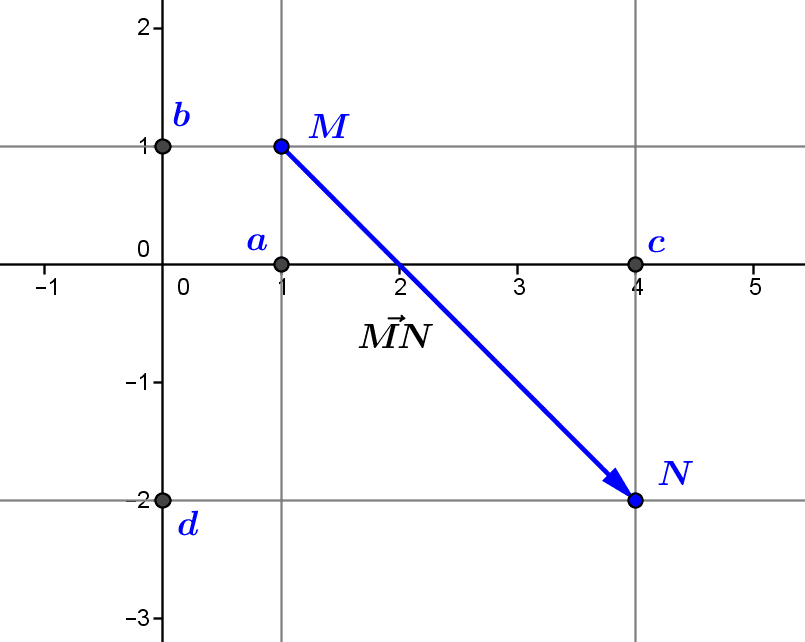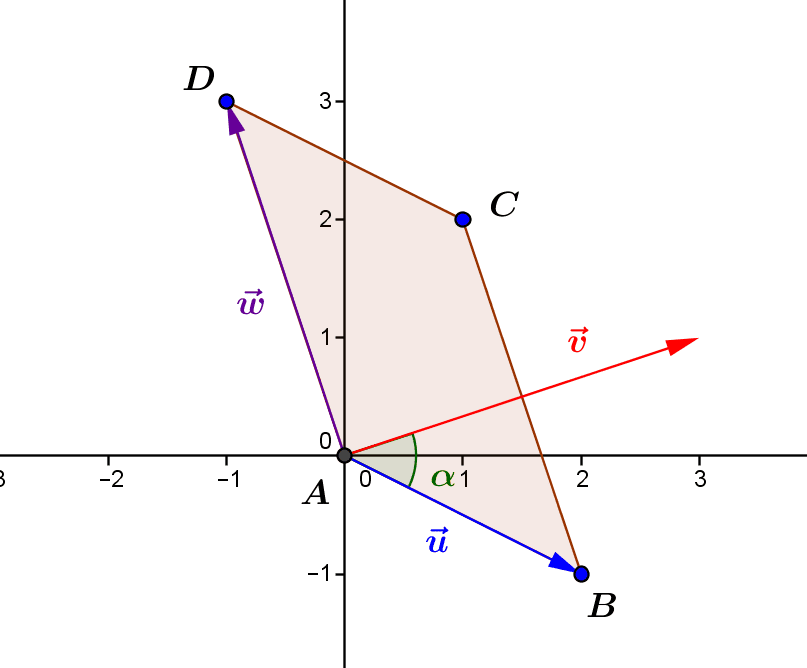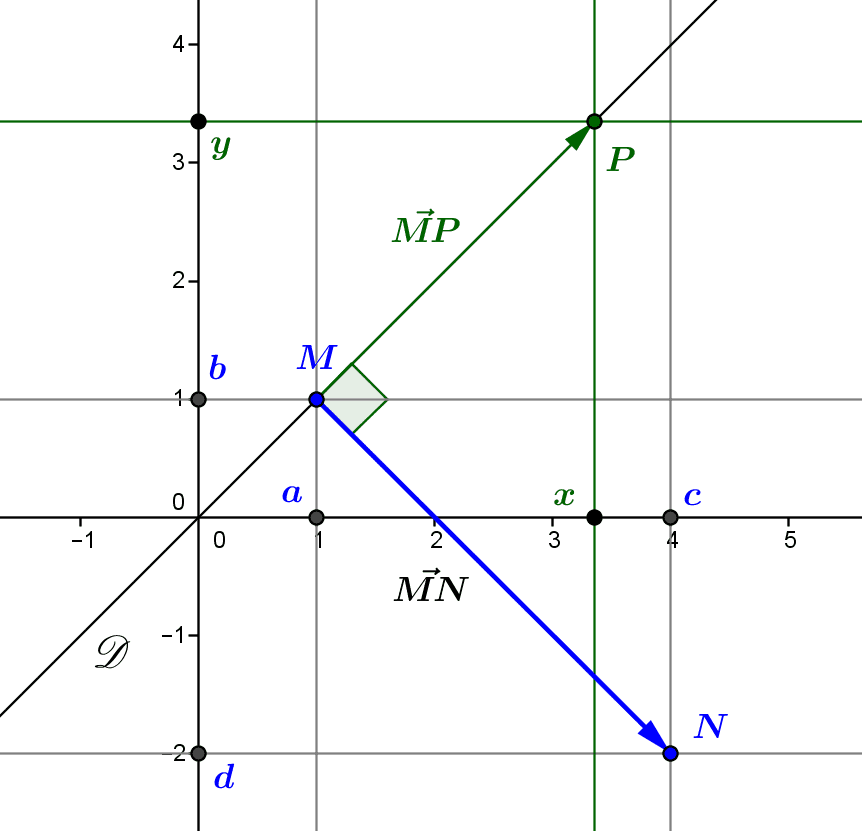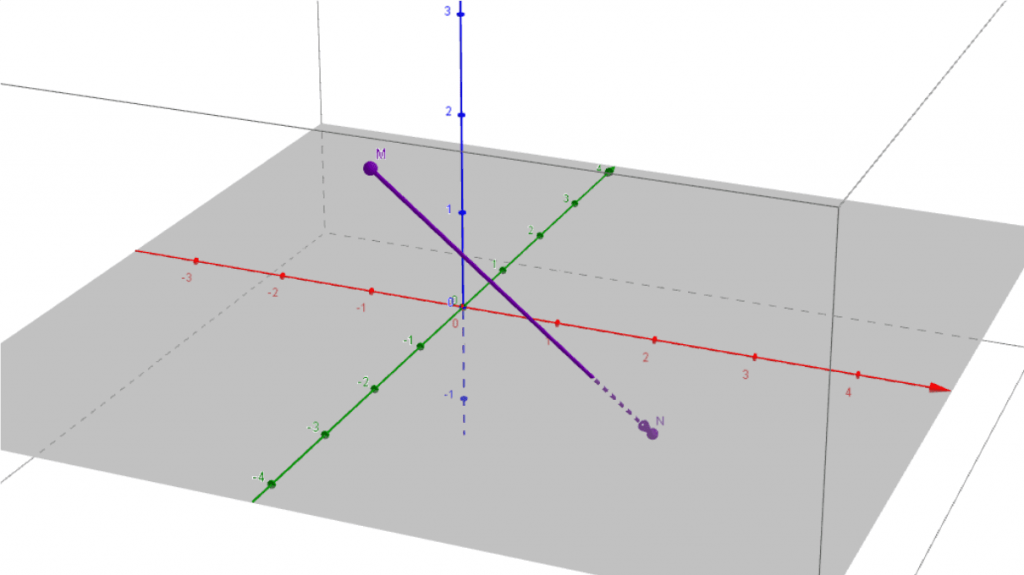The scalar or dot product of two vectors in real space is a real number that takes into account the direction, sense and magnitude of both vectors.
1.The natural scalar product in the Euclidean plane
1.1.From the distance between two points to the scalar product
In the Euclidean plane $\mathbb R^2$, the so-called “natural (Euclidean) distance” between two points $M=(a,b)$ and $N=(c,d)$ is defined as the number $\sqrt{(a-c)^2+(b-d)^2}$. This is because this length is interpreted as the length of the hypotenuse of a right triangle, which can be calculated using the Pythagorean theorem (see The Euclidean Plane). By analogy, in Euclidean (three-dimensional) space $\mathbb R^3$ we also define the natural distance between two points $A=(a,b,c)$ and $B=(x,y,z)$ as the square root of the sum of the squares of the differences of the coordinates. It is thus the real number $d(A,B)=\sqrt{(a-x)^2+(b-y)^2+(c-z)^2}$. Thanks to this definition one can define for example a sphere of centre $A=(a,b,c)$ and of radius $R\geq 0$ as the set of points $M=(x, y,z) of R^3$ such that $d(A,M)=R$, which translates into the equation $(a-x)^2+(b-y)^2+(c-z)^2=R^2$.
If we return to the plane $\mathbb R^2$, we find that the expression under the sign $\sqrt{}$ is of the form $x^2+y^2$ for the real numbers $x=a-c$ and $y=b-d$. In other words, instead of considering the distance as associated with the two points $M$ and $N$, we can consider it as associated with the vector $\vec{MN}=(x,y)\in\mathbb R^2$: this is what we call the norm of the vector $\vec{MN}$, which is noted $||vec{MN}||$. This norm, which measures th magnitude of a vector, is associated with a natural operation between two vectors $\vec u=(x_1,y_1)\in\mathbb R^2$ and $\vec v=(x_2,y_2)\in\mathbb R^2$, which is called the scalar or dot product of $\vec u$ and $\vec v$. This scalar product is defined as the real number $\vec u.\vec v=x_1x_2+y_1y_2$, and we see that the norm of a vector $\vec u=(x,y)$, i.e. the distance $\sqrt{x^2+y^2}$ betweeen its two extremities, is the square root of its scalar product with itself, i.e. $\sqrt{\vec u.\vec v}$.
In the following figure, the coordinates $(c-a,d-b)$ of the vector $\vec{MN}$ are readable from the coordinates of the points $M$ ($a,b)$ and $N$ ($c,d)$. The norm of the vector is then the distance between $M$ and $N$, i.e. $\sqrt{(c-a)^2+(d-b)^2}$.

1.2.A real product with a geometric meaning
Why is this operation called a product? Because it has properties similar to the product of two numbers. For example, if $a,b,c\in\mathbb R$ are three real numbers, we have the well-known property of distributivity of multiplication over addition, i.e. the equality $c\times (a+b)=c\times a+c\times b$. In the same way, for three vectors $\vec u=(a,b)$, $\vec v=(x,y)$ and $w=(z,t)$ of $\mathbb R^2$, we have \[\vec w.(\vec u+\vec v)=z\times (a+x)+t\times (b+y)=(za+tb)+(zx+ty)=(\vec w.\vec u)+(\vec w.\vec v).\] We see that this distributivity of the dot product on the addition of vectors comes in fact from the distributivity of $\times$ on $+$ in the set $\mathbb R$. In the same way, if $a$ is a real number, one can easily show that $\vec u.(a\vec v)=(a\vec u).\vec v$, which is rather similar to the commutativity and associativity of the product of two numbers. Let us also note that the scalar product is symmetrical, i.e. that $\vec u.\vec v=\vec v.\vec u$.
In the plane, the scalar product has an indirect geometric interpretation. If we consider the (non-oriented) angle $(\vec u,\vec v)$ formed by the vectors $\vec u$ and $\vec v$, we can give a trigonometric expression of the dot product of $\vec u$ and $\vec v$ in the form $\vec u. \vec v=||\vec u||\times ||\vec v||\times \cos (\vec u,\vec v)$. From there, if we consider that two vectors determine a parallelogram, then the scalar product $\vec u. \vec v$ is the signed area (i.e. taking into account the sign, i.e. a positive or negative number) of the parallelogram determined, not by the vectors $\vec u$ and $\vec v$, but by $\vec u$ and the vector $\vec w$ obtained by applying a rotation of angle $\pi/2$ (a quarter turn to the left) to the vector $\vec v$. The area is signed because the cosine of the angle between $\vec u$ and $\vec v$ is positive or negative, depending on whether the (non-oriented) angle is acute (between $0$ and $\pi/2$) or obtuse (between $\pi/2$ and $\pi$).
On the following figure, one can visualize the scalar product $\vec u.\vec v=||\vec u||\times ||\vec v||\times \cos\alpha$ of the vectors $\vec u$ and $\vec v$ as the signed area of the parallelogram $ABCD$ constructed from the vectors $\vec u$ and $\vec w$, where $\vec w$ is obtained from $\vec v$ by an clockwise rotation of angle $\pi/2$, and where $\alpha$ is the angle between $\vec u$ and $\vec v$. The sign of the dotr product is positive here, because the angle $\alpha$ is acute.

1.3.A measure of orthogonality
Thus, the scalar product of two vectors is a real number that combines both the direction and the sense of two vectors through the angle they form. It can therefore be used as a criterion for determining the orthogonality (the vector analogue of perpendicularity) of two vectors, and thus of two lines for example. In this sense, it is a “measure” of the orthogonality of two vectors, and can even be used to define when two vectors are orthogonal.
Two vectors $\vec u$ and $\vec v$ are, in fact, said to be orthogonal, by definition, when the (non-oriented) angle they form is a right angle. Using the trigonometric expression of the scalar product $\vec u.\vec v=||\vec u||\times ||vec v||\times \cos(\vec u,\vec v)$, we see that this scalar product is zero exactly when one of the vectors $\vec u$ or $\vec v$ is of zero norm, or when $\cos(\vec u,\vec v)=0$. If therefore none of the vectors $\vec u$ and $\vec v$ are zero, their scalar product is zero if, and only if, they are orthogonal. This makes it possible, for example, to calculate directly the equation of a line orthogonal to a given line when a directing vector of the line is known.
In the following figure, which repeats the first, we show how the scalar product can be used to find a Cartesian equation of the line $D$ orthogonal to the vector $\vec{MN}$ at $M$. A point $P$ with coordinates $(x,y)$ is on this line $D$ if and only if the vectors $\vec{MN}$ and $\vec{MP}$ are orthogonal, in other words if and only if $\vec{MN}.\vec{MP}=0$, or $(c-a)(x-a)+(d-b)(y-b)=0$. By developing, we obtain a Cartesian equation of $D$ of the form $(c-a)x+(d-b)y-a(c-a)-b(d-b)=0$, whose coefficients are written from the coordinates of $M$ and $N$.

2.Scalar products in higher dimensions
2.1.The natural scalar product in dimension 3
In the $3$-dimensional real space $\mathbb R^3$, the geometry of angles is rather more complicated, but we can still define a natural dot product. Indeed, the analytical definition of the scalar product in the plane (i.e. the one using coordinates) is inspired by the distance between two points, and uses coordinates. It is possible to “extend” it to vectors in dimension $3$.
We have already given an expression for the distance between two points in three-dimensional space, from which we can derive the norm of a vector $\vec v=(x,y,z)\in\mathbb R^3$: this is the positive real number $||\vec v||=\sqrt{x^2+y^2+z^2}$. As in the case of the plane, the scalar product of two vectors $\vec u=(a,b,c)$ and $\vec v=(x,y,z)$ of $\mathbb R^3$ is then defined as \[\vec u.\vec v=ax+by+cz.\] We can easily verify by calculation that it has the same properties as the scalar product in the plane.
In the following figure, the $x$ axis (abscissa) is shown in red and the $y$ axis (ordinate) in green. We have represented two points of the Euclidean space $\mathbb R^3$, the point $M$ with coordinates $(1,-4,3)$ and the point $N$ with coordinates $(2,0,-1)$. The Euclidean norm of the vector $\vec{MN}$ (represented by the purple arrow) is the distance between $M$ and $N$, i.e. $\sqrt{(1-2)^2+(-4-0)^2+(3-(-1))^2}=\sqrt{1+16+16}=\sqrt{33}$.

2.2.The scalar product in higher dimensions
More generally, if $n$ is a non-zero natural number, let us call “$n$-dimensional real space” the set $\mathbb R^n$ of $n$-tuples of real numbers, i.e. of finite sequences $(x_1,x_2,\ldots,x_n)$ of real numbers. For $n=2$, we obtain the Euclidean plane $\mathbb R^2$ and for $n=3$, we obtain the Euclidean space $\mathbb R^3$. We can then define, in an analogous way, the scalar product of two vectors $\vec u(x_1,x_2,\ldots,x_n)$ and $\vec v=(y_1,y_2,\ldots,y_n)$ of $\mathbb R^n$, as the real number \[\vec u.\vec v=x_1y_1+x_2y_2+ldots+x_ny_n. \] We also have the Euclidean norm $||\vec u||=\sqrt{x_1^2+x_2^2+\ldots+x_n^2}$ which measures the “magnitude” of a vector $\vec u$ and the natural Euclidean distance between two points. In these spaces, the dot product is also used to define a notion of orthogonality, and there is always a version of the Pythagorean theorem.
For $n=4$, we could consider the points or vectors $(t,x,y,z)\in \mathbb R^4$ as the elements of a “mathematical space-time” (where the first coordinate $t$ would represent an ideal time and the three others $x,y,z$ a place in space). We can therefore conceive an element of $\mathbb R^4$ as an “event”. The Euclidean distance between two points is then a distance between two events, which takes into account both space and time (this being said, another form of distance is used in relativity theory). Associated with this scalar product and distance is a Euclidean geometry in dimension $4$, where one can find for example the analogue of the cube (called hypercube or tesseract) and the analogue of the sphere.
2.3.Other scalar products and analogues
Scalar products are examples of functions that are called symmetric bilinear forms. The scalar product presented here is said to be “natural” because it is directly defined from the natural description of the real spaces $\mathbb R^n$, but there exist on each such space an infinite number of other scalar products, which are all other ways of measuring orthogonality and distances, and thus of doing Euclidean geometry.
There are also other types of bilinear forms that are not dot products and allow us to develop similar geometric notions. We have mentioned the Minkowski space-time, which can be thought of as the real space $\mathbb R^4$ on which we have an analogue of the scalar product defined for two vectors $\vec u=(t,x,y,z)$ and $\vec v=(t’,x’,y’,z’)$ by $\vec u.\vec v=tt’-xx’-yy’-zz’$ (compare with the formula for the scalar product). Such a “structure” allows to give a geometrical representation of the physical properties of space-time in special relativity theory (see Wikipedia, Minkowski space).
Finally, there is also a natural complex scalar product, which can be defined in an elementary way on complex spaces $\mathbb C^n$, and which uses complex conjugation. If $z=(z_1,\ldots,z_n),w=(w_1,\ldots,w_n)\in \mathbb C^n$ are two vectors, we define it as $z.w=z_1\overline{w_1}+\ldots +z_n\overline{w_n}$, where $\overline w$ denotes the conjugate of the complex number $w$. Its properties are analogous, but more complex (!), to those of the natural real scalar product, which it extends in a way. Note that it is also possible to define scalar products, real or complex, in infinite dimensional spaces (such as certain function spaces), where one can export notions of Euclidean geometry to do analysis for example. But such a presentation is beyond the scope of this article.
0 Comments